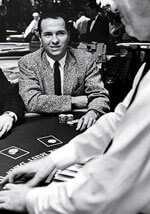This tutorial on Basic Online Blackjack tips and strategy assumes that you have read the introduction to blackjack article which teaches you the game in just three minutes.
Now for the fun part – as a blackjack player you use your wit to squeeze out the most profitable wins at the tables. Blackjack, and not only the online version, is all about the magic number twenty-one.
Online Blackjack strategy is about judging how likely you are to beat the dealer based on the cards that are already placed on the table. There’s some simple arithmetic involved and it will get easier to calculate as you go along so don’t get your knickers in a knot just yet. Read, understand then apply. Also remember the safest place to learn strategy without any pressure is by trying it out online, and using free play. No more deliberation – let’s get straight into it, shall we?
Online blackjack rules: play-by-play
- First and foremost, as most guides will tell you, unless you are a seasoned professional or are very good at counting cards, never take insurance. Insurance is technically just a side bet on whether the dealer has a ten-value face-down card after being dealt an ace that pays out 2 to 1.
- Always split aces and eights. Never split court cards, tens, fives or fours.
- Because tens, jacks, queens and kings are all ten-value cards, there are more ten-value cards than any other cards in the deck. By assuming the dealer’s next card will be a ten-value card, a player can divide the pack into two – cards that will likely bust and cards that will likely win.
- In accordance with this school of thought, if the dealer has a two, three, four, five or six face up card, they are more likely to bust than if they had a higher value card. In this instance, players should aim to avoid busting themselves and not take any big risks. As soon as your card total is over eleven, you should stop taking cards.
Online blackjack at top UK online casinos
[toplists id=”1″ template=”1″]
How to play online blackjack: To hit or stand
If you have a card total of 11 or less, always hit.
If you have a card total of 17 or more, always stand.
If you have a card total of 12 to 16 and the dealer is showing a 4 to 6, always stand, but, if you have a card total of 12 to 16 and the dealer is showing either a 2 or a 3, always hit.
If you have a card total of 12 to 16 and the dealer is showing a 7 or higher, always hit.
If you have a soft ace in play, you can generally be more aggressive than you would be if you had a hard ace in play.
Basic strategy chart – 4 or more decks – soft hand
With a soft hand in online blackjack, the hand contains an ace that counts as eleven and not one. The main element to the basic strategy containing soft hands is to double down when the dealer has a high probability of busting. The surrender option has not been included in this chart, as most modern online casinos today will not offer the option.
| Player’s Total | Dealer’s Up Card | What To Do? |
| 21 | Any card | Stand |
| 20 | Any card | Stand |
| 19 | Any card, except a 6 Stand on all. | Double down if a 6 and stand if doubling down is not permitted |
| 18 | 2, 7, 8, Ace | Stand |
| 18 | 3, 4, 5, 6 | Double down, or stand if doubling down is not permitted |
| 18 | 9, 10 | Hit |
| 17 | 3, 4, 5, 6 | Double down, or hit if doubling down is not permitted |
| 17 | 2, 7, 8, 9, 10, A | Hit |
| 16 | 4, 5, 6 | Double down, or hit if doubling down is not permitted |
| 16 | 2, 3, 7, 8, 9, 10, A | Hit |
| 15 | 4, 5, 6 | Double down, or hit if doubling down is not permitted |
| 15 | 2, 3, 7, 8, 9, 10, A | Hit |
| 14 | 5, 6 | Double down, or hit if doubling down is not permitted |
| 14 | 2, 3, 4, 7, 8, 9, 10, A | Hit |
| 13 | 5, 6 | Double down, or hit if doubling down is not permitted |
| 13 | 2, 3, 4, 7, 8, 9, 10, A | Hit |
Basic strategy chart – 4 or more decks – hard hand
A hard hand in blackjack is when the hand contains either no aces or when the ace counts as one. The surrender option has again not been included in the hard hand chart.
| Player’s Total | Dealer’s Card | What to Do? |
| 21 to 17 | Any card | |
| 16 to 13 | 2, 3, 4, 5, 6 | Stand |
| 16 to 13 | 7, 8, 9, 10, A | Hit |
| 12 | 4, 5, 6 | Stand |
| 12 | 2, 3, 7, 8, 9, 10, A | Hit |
| 11 | 2, 3, 4, 5, 6, 7, 8, 9, 10 | Double down, or hit if doubling down is not permitted |
| 11 | A | Hit |
| 10 | 2, 3, 4, 5, 6, 7, 8, 9 | Double down, or hit if doubling down is not permitted |
| 10 | 10, A | Hit |
| 9 | 3, 4, 5, 6 | Double down, or hit if doubling down is not permitted |
Online blackjack tips: one by one
As mentioned before, putting a strategy in place reduces the house edge considerably. There are, however, those that count cards in an effort to beat the house completely. It is a legal practice, but casinos reserve the right to ban any player they feel is doing a little too well, and, since they are likely to have been in business much longer than you have been counting cards, it is quite easy for them to spot you. For this very reason, casinos put in continuous shuffling machines or shuffle the decks whenever players start to suddenly bet bigly.
The principle here is that high-value cards are better for the player who is wishing low value cards (fours, fives and sixes) upon the dealer. The more aces and ten-value cards there are, the more likely the player is to get blackjack, or to beat the dealer.
To keep track of what cards are most likely to be coming out next, players can use one of a few methods. For the purposes of keeping this a basic guide for beginners, let’s just look at the most popular method. Please note, however, that you cannot count cards at an online casino.
 Outdated: The Thorpe Method
Outdated: The Thorpe Method
Edward O. Thorp is considered by many to be the forefather of card counting. A passionate physicist and mathematician, Thorp experimented with and ultimately validated his technique with the help of Manny Kimmel, an illegal bookie, who contributed starting capital. Shortly thereafter, Thorp published his book, “Beat the Dealer”, which quickly became the recommended guide for blackjack players looking for a further edge over the house.
The method assigns a value to a card which is used to keep a running tally. Players add one to their running count for every card with a value of two to six, and minus one for every card that has a value of ten to ace. Cards with a value of seven to nine are assigned zero.
By using this count, players are able to keep track of what cards were left in the pack, and therefore know when to increase their real money bets – all this by knowing if the card tally is positive, negative or ‘neutral’.
When the running count is positive, players are more likely to get high-value cards. As high-value cards give the player an advantage, real money bets would be larger while the running count is positive.
When the running count is negative, players are more likely to get low-value cards. As they have to hit on stiff hands, low-value cards give the dealer an advantage. Therefore, bets by the players would be smaller. Due to the popularity of online blackjack, the above method becomes outdated as players are no longer able to use card counting due to the RNG process (Random Number Generator Process).









